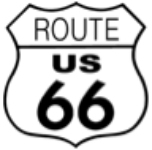
It is a beautiful place with an expanse of green grass, a few trees and many others further back from the road, and they take enough time eating to relax and enjoy the scenery.

In this partial account of the **Atkins Family’s 1948 U.S. Route 66 journey west, the family has just left the Seaba Station eight miles west of Chandler Oklahoma on Route 66, (the subject of the last blog entry,) and has crossed under the 1928 Trestle bridge and driven across the Deep Fork River concrete bridge. They approach the small community of Wellston Oklahoma.
When the family sees the Pioneer Courts at the junction of Route 66 and Route 66b into Wellston they have to make a decision. Straight ahead is the section of Route 66 known as the gap, added in 1933 to bypass the town. To their right is the original road now designated as 66b, which travels northwest, loops through town then back southwest to rejoin Route 66.
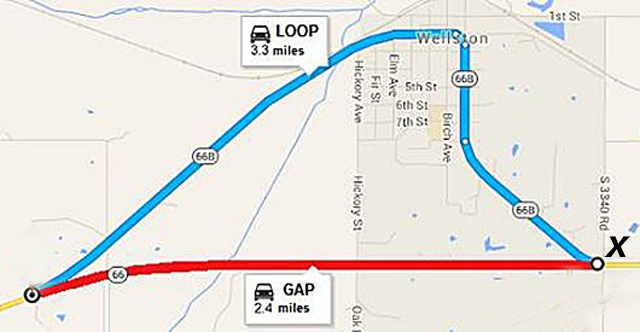
Wellston Loop and Gap
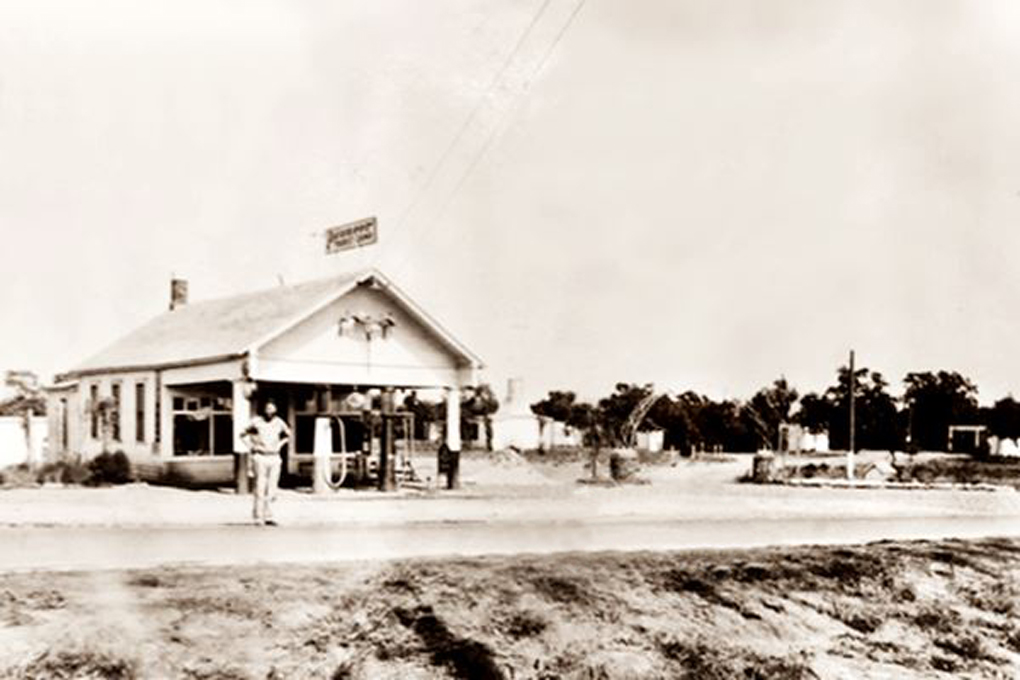
The Pioneer Station with Courts behind
They opt to continue going straight across the gap.
About four miles west of Wellston, the road curves in a steep southwesterly dip to merge into E0930 and head straight west again.
Shortly after, about three miles before reaching Luther, they reach the Threatt Filling Station. It’s on the SW corner of Route 66 and N. Pottawatomi Road, the County line.
Allen Threatt Sr. built the station between 1915 and 1920 using local sandstone. It was designed in the “house style”, with the appearance of a bungalow with a four gabled shingle roof. In 1948 there was also a grocery, added in 1935, and the café, added in 1937 named “The Junior.”

Threatt Station
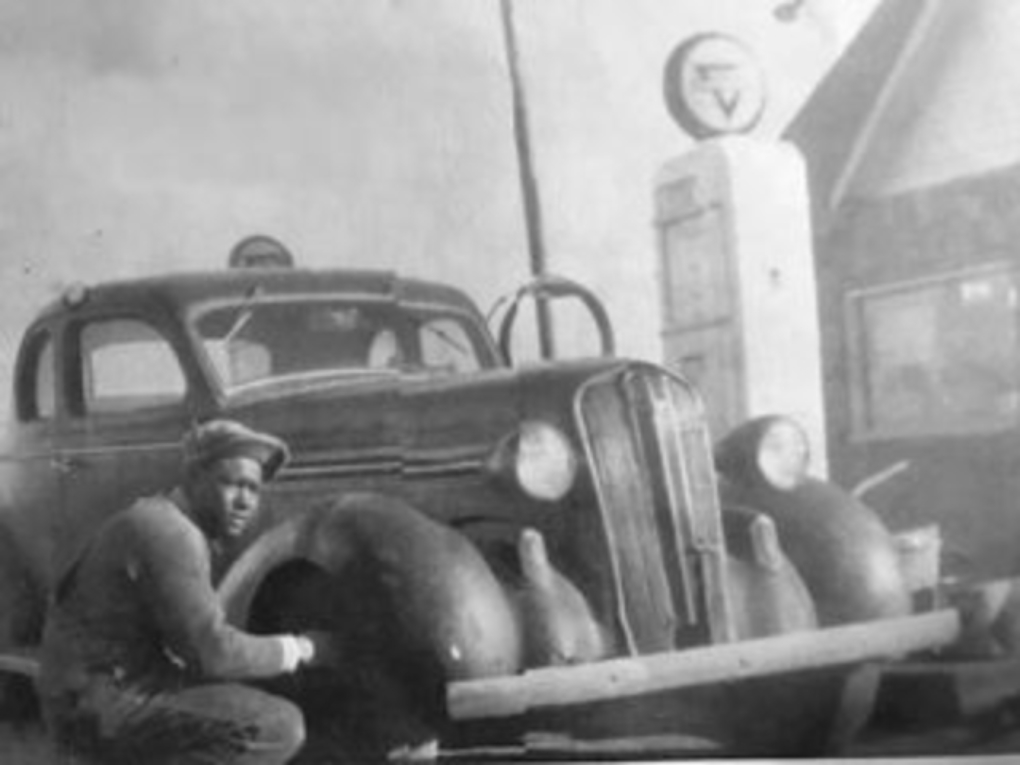
Ulysses Grant Threatt
The Threatts, an African American family, came to the Oklahoma Territory for a new start as homesteaders in Luther when the area was opened in 1889. There were no laws in the territory restricting their freedoms, but when Oklahoma became a state in 1907, Jim Crow laws were passed similar to what existed in other states.
African Americans especially appreciated the Threatt Station. In the 1940s, many businesses along Route 66 would not serve them. If you were African American, a trip down U.S. Route 66 took a lot of planning, a “Green Book” travel guide that listed places where you were welcome, and a good chunk of luck.
At the Threatt station, motorists, black or white, could get gas, food, car repair service, a free place to park for the night, good conversation and much needed information.
The Atkins family doesn’t need gas at this point, so they drive on by.
US Route 66 passes on the north edge of Luther. West of the town, Route 66 crosses a bridge over the Frisco Railroad, then curves right to cross the brooding, often fast flowing and tempestuous Deep Fork River, putting it again on the south side of U.S. Route 66.
After a few more miles, the road curves northwest. There are very few homes or buildings of any kind, just the road surrounded by the local trees – oaks, cottonwood, cedar and others. Then U.S. Route 66 heads straight west again, passes over Soldier Creek, which branches off of the Deep Fork, and curves southwest heading toward Arcadia.
The family’s Chevy starts sputtering a bit and Luke says that he thinks it is not getting enough gas, and that he needs to find a place to adjust the carburetor. Ahead, coming up on Arcadia, on the left he sees an open field with a square cement or rock block on the ground with an attached plaque that they cannot read from the road.
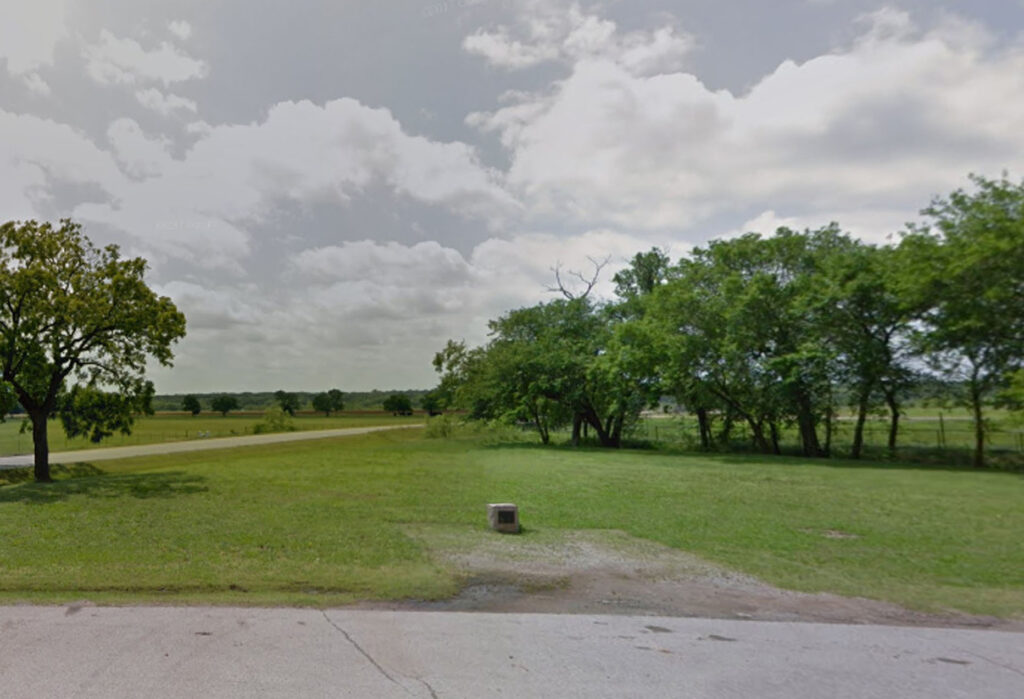
The Washington Irving Campsite near Arcadia, Oklahoma

The block marker there in 1948 reads as follows:
“The Washington Irving Party and a troop of U.S. Rangers encamped on this spot Oct. 24, 1832.” And adds at the bottom: Erected by the Arcadia Public School, and the Oklahoma City Chapter D.A.R 1932.
Luke pulls off into the field and stops under a tree.
As he opens his car door and steps out, he says to Grace. “You might as well get us out something to eat while we’re here.”
Luke opens the trunk and pulls out his screwdriver, raises the hood from the driver’s side, and bends his thin nearly six-foot frame under it and starts working on the carburetor.
Under the fedora that he always wears over his wavy light brown hair, his intense deep blue eyes and firm set mouth show he is totally focused on his task.
Earlier, when the family left Grandma’s house near Stillwater, she sent with them a sack of food; Grace takes it out now. Sunlight glints off her auburn hair as she arranges it on a blanket spread out on the ground — fried chicken, potato salad, baked beans, bread, and cookies along with some eating utensils, and plates.
After a few minutes, Luke finishes with the car, shuts it off and comes over to join the rest of the family on the blanket. Luke says a blessing and they help themselves to the food, and, to drink, Grace pours the kids the cherry Kool-Aid from their thermos, and coffee from another for her and Luke.
It is a beautiful place with an expanse of green grass, a few trees and many others further back from the road, and they take enough time eating to relax and enjoy the scenery. It seems the family feels like they are on a fun adventure. It seems like a true picnic.
Nancy, who doesn’t yet read, asks Grace to read the marker. She walks over to it, comes back and says, “The marker tells us that this is the spot where Washington Irving and a troop of U.S. Rangers camped in October of 1832”
“Who’s he?” Nancy asks.
“He wrote a book about this area a long time ago. It was called Tour of the Prairies.”
“Never heard of it,” Carl says, “Sounds boring”.
Luke asks, “Well, have you ever heard of Rip Van Winkle?”
“Yeah,” Carl says, “He’s that man with the long beard that slept for a hundred years.
“Yep, and what about The Legend of Sleepy Hollow, about the headless horseman.
“Yeah, scary.”
“Well, Washington Irving wrote both of them.”
“Oh.”
“Back in Irving’s day, there were only some trails; there weren’t any roads, or railroads, and Oklahoma wasn’t even a state yet and Texas was still part of Mexico. The Red River was the border to Mexico instead of Texas.”
“Wow.” Carl says.
“We better get going, don’t you think?” Grace asks.
“Yeah, we better, it’s after five.”
Grace looks around and says, “Kids, help me pick up this trash.”
They do and Grace puts it all in the chicken sack, and sets it in the floorboard of the Chevy on the front passenger side to be thrown away first chance. She puts what is left of the bread, cookies, Kool-Aid, and whatever else back in the trunk, picks the blanket up, shakes it out and then folds it and lays it across the other things. Then the family climbs back into the car.
Luke turns the key in the ignition. The Chevy does a poor imitation of trying to start, sputters and spits then gives up.
“Don’t worry,” he says, and gets out of the car, gets his screwdriver, and again raises the hood.
“Grace, sit behind the wheel and give the car gas when I give you a sign.”
She scoots over to the driver’s side and watches for Luke’s signal and manipulates the gas pedal while Luke adjusts the carburetor to allow more gas into the gas and air mixture. It is a delicate operation but after about 10 minutes the car is running smoothly again. Grace scoots over to the passenger side, Luke gets in and they take off down Route 66 into Arcadia.
* * * * *
Coming Next – Arcadia through Oklahoma City
Notes:
*The Atkins Family: Luke (Father, 38), Grace (Mother, 29), Carl age 10,) Darla (age 6,) Nancy (age 4.)
Because of my need to cut the word count of my book down significantly from nearly 130,000 words, many cuts are those that added to historical value rather than story. It makes me sad because I like those historical references. I hope that by presenting some of those here, I can share an authentic 1948 trip down Route 66 and add a little extra as I go.
My parents made a real 1948 trip to California and my mother kept a diary, which I faithfully used in planning this fictional trip.
Cut: The rather long scene and any mention of the Washington Irving Rest Stop has been cut from the final manuscript of Tumbleweed, as well as most detail for Wellston and Luther. I’m including it here because I think/hope it is interesting.
Credits: Jack DeVere Rittenhouse, (1946). A Guide Book to Highway 66
Image Credits:
- R66 Shield Transparent pngegg tiny: www.pngegg.com
- 1937 Chevy 4-door Sedan: Photoshop on personal picture.
- Pioneer Tourist Court: www.theroute-66.com
- Map: Wellston Loop / Gap: www.theroute-66.com
- Threatt Station: www.route66news.com
- Washington Irving Rest Stop Google Screen Shot Cropped, edited
- Washington Irving Marker, close Google Screen Shot Cropped
* * *
